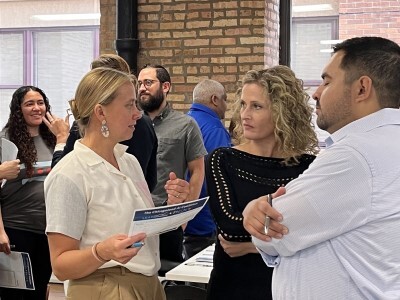Technology Tools
Student as Designer: Making EdTech that Increases Student Success
Topics

Educators often take advantage of educational technologies as they make the shifts in instruction, teacher roles, and learning experiences that next gen learning requires. Technology should not lead the design of learning, but when educators use it to personalize and enrich learning, it has the potential to accelerate mastery of critical content and skills by all students.
How can undergraduate student involvement lead to wider tech adoption and better academic outcomes?
Last week, I wrote about ways to support and engage faculty in order to successfully implement a tech-enabled innovation designed to promote student success. This week, I focus on students.
"Involving undergraduates extensively in [BioBook’s] development and refinement was the single most important effective strategy that we used. Their insights were critical to identifying and overcoming near-peer learning barriers."
–A. Daniel Johnson and Sabrina D. Setaro, Wake Forest University
Based on the experience of the BioBook project team and all of NGLC’s Building Blocks for College Completion grantees, we have concluded that one of the seven practices in facilitating the adoption and success of student success innovations is to:
Engage students as designers and facilitators of an innovation as well as learners.
1. Help students understand the innovation’s relevance and benefits to promote their participation and achievement.
SRI International, external evaluator of the Building Blocks for College Completion grant projects, reported that active and self-directed course design promoted greater positive effects on student outcomes.
But students did not automatically embrace the innovations. SRI identified “student resistance” as one of the challenges observed by some grantees.
For example, the University of the District of Columbia Community College project struggled to engage students in optional resources and supports provided through the project. The project team reported to NGLC that not one student who was given a user ID and instructions accessed the Learner Web website on a continual basis. The team considered using posters, flat screens on walls, email blasts, and Facebook campaigns to raise students’ awareness of the program’s benefits, but these efforts never got off the ground.
It’s possible that students may not have found the tool useful. But in hindsight, the project team believed the students did not recognize how they could foster their own success by taking advantage of the program tutors and the Learner Web website. More closely integrating the innovation into the course design as opposed to only offering the program as a supplemental volunteer option might have increased student participation.
Conversely, the University of Wisconsin-Milwaukee’s U-Pace project fostered students’ perception of their innovation’s relevance in a number of ways. The team developed 50+ templates to guide instructors on giving feedback to students for a broad range of courses and student profiles. The feedback helped motivate students and taught them study skills that will facilitate their success throughout their college years. In addition, the course assessments involved deeper thinking and real-world applications of the material, and the students who participated in U-Pace had a significantly greater likelihood of successful course completion than those who took the course without the U-Pace component.
A survey of U-Pace students found participants had a stronger sense of achievement as well as more positive perceptions of instructor support, instructor willingness to help, and their own knowledge of the course subject matter.
2. Involve students in the student success innovation’s design and implementation to enrich their learning and strengthen the innovation’s overall impact.
For example, Wake Forest University creatively turned a crisis into an advantage, recruiting undergraduate student assistants to work on its BioBook project when lack of funds precluded the hiring of additional content authors and reviewers. Today, students assist in BioBook’s development, where they have become valuable resources for content development and refinement while enhancing technical skills such as:
- adding wiki coding;
- creating illustrations or photographs of specimens and video;
- building supplemental exercises; and
- reviewing content.
In a blog post reflecting on this outcome, BioBook project lead A. Daniel Johnson said, “Students will invest deeply in an authentic project that has tangible outcomes.” He conveyed the team’s sense that deeply involved student partners can provide rich feedback much earlier in the development process, identifying learning barriers that instructors and book authors do not see.
The University of Hawaii hired students as ambassadors for its STAR course enrollment and planning system implementation. The student ambassadors engaged with their peers to provide training and mentoring for the system. The ambassadors also built awareness of the university’s graduation initiatives to create sustained impact and gradual cultural change.
The strategy worked; students’ usage of STAR increased more than anticipated during the grant project. Some campuses opted to continue the ambassador program after the project ended, using their own funds to hire peer mentors.
3. Anticipate training needs to bolster students’ technology proficiency.
SRI found that the technology readiness of students was another challenge for some grant projects—an unanticipated finding. We tend to label today’s students as “digital natives” but not all are necessarily proficient in using their own devices for educational purposes.
Texas-based Abilene Christian University’s Mobile-Enhanced Inquiry Based Learning (MEIBL) project managers discovered that a surprisingly large fraction of partner institutions’ students were reluctant to admit their unfamiliarity with smartphones and tablets, and their difficulty in accessing the project videos and applications from mobile devices.
To address this, the project team worked with the university’s teaching and learning center to loan iPod Touches pre-loaded with the project’s podcasts to the student participants.
Similarly, Wake Forest University’s project managers realized students needed instruction on how to use BioBook and developed short, one-to-two minute tutorials to demonstrate BioBook’s key features.
What are some other effective strategies you have seen for authentically engaging students in the development and adoption of tech-enabled innovations?
The next post in this series examines the role of project communities in accelerating adoption of a new tech-enabled innovation.
--
This post is part of a series on technology-enabled innovations designed to promote student success. Read the first post and view the infographic summarizing the findings from NGLC’s first wave of grantmaking. All findings are drawn from an external evaluation conducted by SRI International as well as grant recipients' results and observations.




